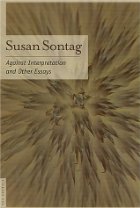Susan Sontag: why style is important
I love reading things that introduce me to a new way of thinking. To hold a (good) book in your hand is, as Anne Michaels wrote in Fugitive Pieces, to be ”a pilgrim at the gates of a new city.” Susan Sontag’s Against Interpretation, particularly the opening essays, is exemplary of just such a book.

“Against Interpetation” is an essay presenting ideas which I was familiar (i.e. that certain types of interpretation of artistic work that are still current today are overly reductionist and simplifying, and make the art merely a stand-in for a message), though it sets the stage for the second, lengthier and, I think, more challenging essay, “On Style,” which in a fairly sophisticated way argues that the purported overcoming of the style/content distinction in artistic analysis has not in fact taken place, and that “style” itself, rather than being a merely superficial decoration on a substantive, important “content,” is actually an aspect of artistic works that is consistently undervalued and glossed over in appreciation and criticism of art.
Sontag in fact asserts that style is the most important element in a work of art, and it is style (which sometimes appears as a short-hand for “form”) that is the specifically aesthetic quality of a work of art, and therefore deserves the most attention.
Tracing the nuances of Sontag’s argument strikes me as a task ill-suited to a blog, so I encourage to read the essay itself (which isn’t terribly long).
While, as I mentioned, I find Sontag’s argument a useful and compelling new lens for looking at the world and art, her devaluation of the “content” aspect of art strikes me as over-hasty, and narrow—much as she chides Lukacs in a later essay for discounting modernist fiction as bourgeois and naive, I find the implicit discrediting of the importance of narrative in art (see Martha Nussbaum) and the whole mimetic tradition to be somewhat frivolous.